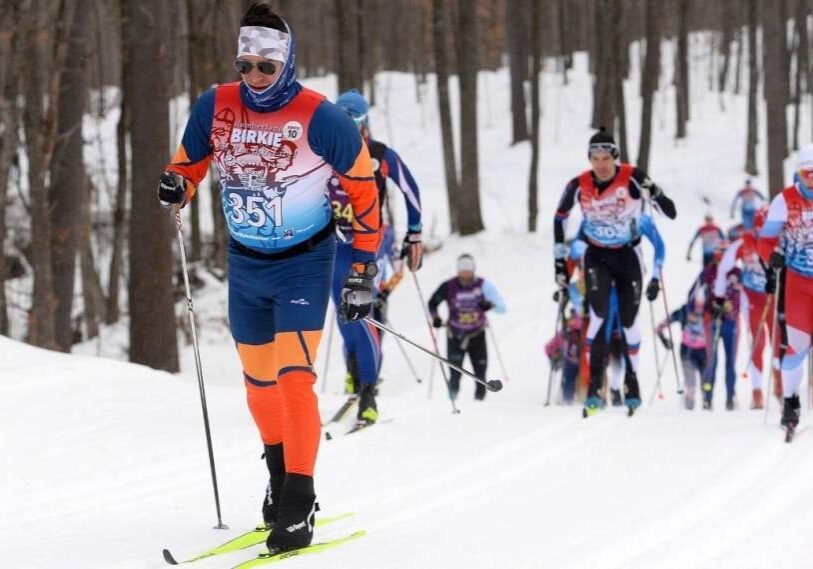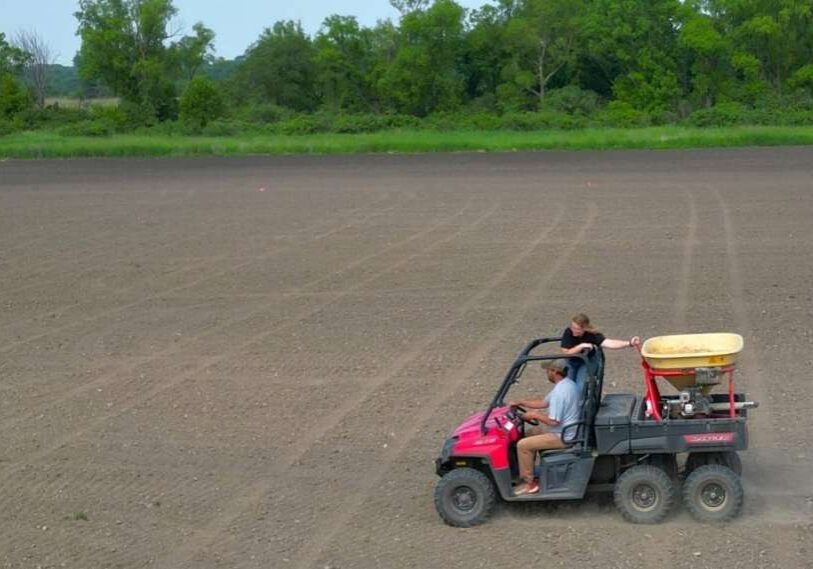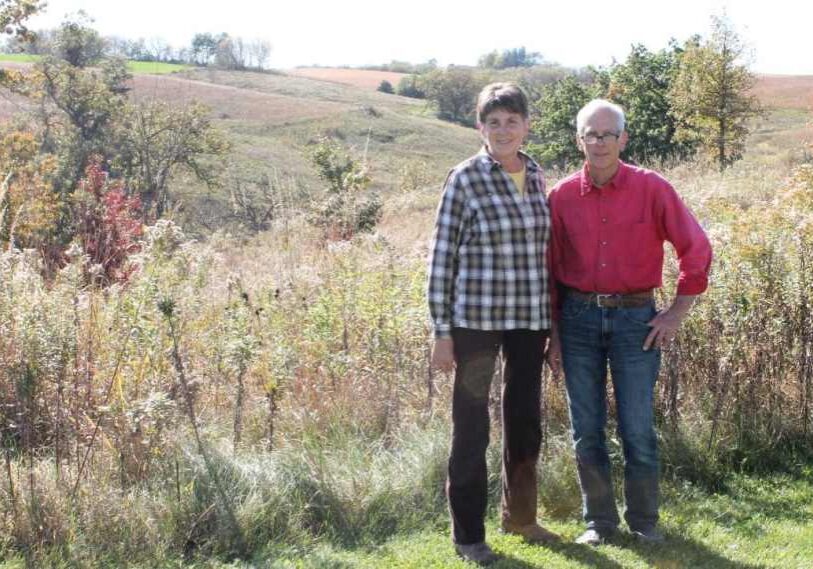Walk the Walk and Talk the Talk, Too

SOUTHEAST MINNESOTA – Eric and Michelle Heins are walking the soil conservation walk as they build a forage-based farm enterprise north of Altura in Wabasha County. They talk the talk as well, hosting pasture walks and discussing their conservation efforts with their sons and daughter. While each is important, the latter is laying the groundwork for the next generation of conservation.
“I grew up working on a farm, but I reflect back on how little I understood about the decisions being made or to ask questions about them,” says Eric Heins. “We are trying to teach our kids about what we are doing and why we do grazing instead of raising row crops.”
Grounded in economics
The lessons are grounded in economics and in a philosophy of caring for the land. “Our 14-year-old son would like to be driving large tractors like his friends, but when I ask if he wants to pay for them, he says no,” says Heins. “He understands that we are trying to keep our overhead low. Grazing animals and planting perennial crops is a way that works for us.”
Reintroducing cattle to the land is the key to Heins’ plan, and it seems to be working. Eric and Michelle had an opportunity to buy a house with 20 acres in 2014. They converted 15 of the 20 acres to pasture, with the idea of practicing rotational grazing and raising grass-fed beef to market locally. After researching breed options, they settled on Normande.

A new Normande calf on the Heins’ land near Altura, Minn. (Photo by Eric Heins)
“I wanted a smaller frame animal that did well on grass and was an easy keeper,” says Heins. “I knew some farmers who had them, did some research and talked to others who had them. We took a chance and bought 4 heifers with a bull lease agreement.”
Custom grazing as part of a low-overhead approach
Quickly realizing they had more pasture than they needed, Heins found a cattle owner on Craigslist who was looking for some pasture. Before he even knew what ‘custom grazing’ was, Heins was doing it. Six years later, he has refined and expanded the practice in parallel with expanding land ownership and land rental.
While Heins received some initial guidance from the local Natural Resource Conservation Service, his main mentor in grazing has been Greg Judy, a nationally recognized custom grazer. Judy has shared his experience building a grass-fed, multi-species, livestock operation, largely with leased land in multiple books and presentations around the country.
“I truly have learned a lot from Greg Judy’s books,” says Heins. “His low overhead approach to everything is really key to our success.”

Pasture view at sunrise, Hoosier Ridge Ranch. The Heins rotationally graze their own herd and custom graze during the growing season, with the goal of grazing every square inch of land to minimize inputs. (Photo by Eric Heins)
He notes that custom grazing has been a good diversification as he and his wife have built their own herd. “It’s nice to bring in a herd in the spring and send them home for the winter,” says Heins. “It has also allowed us to compare rate of gain between our Normande and other breeds. Our calves gain more weight over the course of the summer than the others do. “
Renewing owned and leased cropland with animals and cover crops
Over the same six years, the family moved to an 80-acre farm, where they built a house, shop and barn. They also rent about 350 acres of cropland and another 50 acres of pasture. With five-year leases on both, Heins is comfortable investing in fencing and seeding down some of the land in row crops to forage. Fields that remain in row crops are planted to cover crops in the fall, providing additional grazing in years with good growth. Fields seeded to a mix of orchard grass and alfalfa are harvested in small square bales for sale to horse owners, as well as overwintering the family herd.
“We brought cattle back to fields that have been in corn and soybeans for decades,” says Heins. “With the cover crops, we are keeping plants growing in the soil as long as possible and cattle grazing as long as possible throughout the year. We try to custom graze for 180 to 220 days, depending on what we have for cover crops to graze. In the winter, bale grazing keeps nutrients on the fields and out of the barn with limited labor.”
Heins sees the benefits grazing, forage and cover crops bring to the land on his 80 acres. He is eager to spread those benefits across his newly leased acres, something his landlords are open to him doing. This year he planted cover crops on 60 acres of leased, tillable land. He picked up another 200-acre rental and has a goal of 50 acres of cover crops on it this year, eventually having the entire property in cover crops or forage.
“We did a water infiltration test on a grazed field, and it absorbed an inch of rain in around 45 seconds,” he says. “We ran the same test on a newly leased field that hadn’t yet had cover crop or grazing, and after six minutes we gave up waiting. The water just seemed to sit there. If we can keep water in the soil, we aren’t sending nutrients and soil into the streams.”
Water retention
Harvesting water through improved infiltration is just one way Heins hopes to prevent soil erosion and improve water retention. He and Michelle are working with their Wabasha County Natural Resources Conservation staff on others.
“We are looking at putting in several ponds where we have seen significant runoff with steady rains,” he says. “The previous owner of our farm put in some water barriers to catch and hold runoff, but they were not adequate, and the water broke through. We are working on plans to rebuild them better.”
Woodland grazing
One of Heins’ goals is to make better use of what once were oak savannas with native grasses. Over time they became mixed species woods. Using selective logging, he has opened up the canopy in hopes of releasing the native prairie and using the area for midsummer grazing.
“Initially we are seeing a lot of weeds, some of which the cattle do graze,” says Heins. “In some areas we have introduced some shade tolerant, cool season grasses and clovers, even some radish. In addition to grazing our cattle on it, we are seeing more deer, rabbits and other wildlife where we have implemented these practices.”
Growing up on a dairy farm, Heins recalls all too well the practice of turning dry cattle into wooded areas for the summer. The results of overgrazing and supplemental feeding were patches of compacted dirt.
“We limit grazing in our wooded areas,” he says. ” We save our wooded areas for days of extreme heat when the cattle can really use the cooler shade.”

Michelle and Eric Heins and children Braydon, Adelyn and Grayson enjoy a moment in the spotlight when named Southeast Minnesota Outstanding Conservationist by Minnesota Association of Soil & Water Conservation Districts, December 2022. (Photo by Minnesota Association of Soil & Water Conservation Districts)
Crop diversity experiments
For the first time, Heins will have some rented land in corn and soybeans. They will be custom planted and harvested this year, but over time he plans to convert them, like he has his own acres, largely to oats, barley and hay crops.
“We are still doing some chisel plowing on rented acres to get corn residue under control,” says Heins. “However, we are striving to do no-till in the future as much as we can.”
This year he plans to experiment with planting canola. Like the small grains, an early canola harvest will allow him to follow with cover crops sooner and more likely do fall grazing.
Another crop Heins will be experimenting with is Kernza, the perennial wheat being promoted by the University of Minnesota’s Forever Green program. “A perennial grain like Kernza is one more way of reintroducing cattle to the land,” he says.
Heins understands his and Michelle’s full-time jobs off the farm have given them the freedom to make choices that might otherwise be more difficult. “We are fortunate we don’t have to stick with proven cash crops like corn and beans,” says Heins. “We are using this time to narrow in on what we want to do when farming full-time. It lets us experiment more than others may be able to do.”
Resources by Greg Judy, recommended by Eric Heins: Contact Greg Judy at Green Pastures Farm, 21975 Devil’s Washboard, Clark, MO 65243, Email: gtjudy4099@gmail.com This story is one in a series of stories entitled Smarter Together, featuring southeast Minnesota farmers and landowners who are innovating with partners across a variety of landscapes to achieve their own goals for land stewardship, their families and communities. The project began as a conversation with retail crop advisors who were looking for ways to support customers, increase nutrient efficiency, and address water quality concerns. The project is administered by Winona and Wabasha County Soil & Water Conservation Districts; produced by NewGround, an independent strategic communications group; and funded by Minnesota Pollution Control Agency and Minnesota’s Clean Water Land and Legacy Fund.






